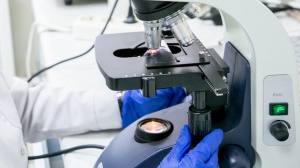Belarusian, Russian scientists up operational temperature of terahertz quantum cascade laser

MINSK, 24 November (BelTA) – Scientists of the Belarusian State University (BSU) together with Russian colleagues have improved the operational temperature of a terahertz quantum cascade laser. Cutting-edge work to create laser equipment with the specified parameters is in progress all over the world, the BSU press service told BelTA.
Several collaborations of scientists have been working on quantum cascade lasers in the post-Soviet space for the last five years. One of them includes representatives of the Belarusian State University, the V.G. Mokerov Institute of Ultra High Frequency Semiconductor Electronics of the Russian Academy of Sciences, the National Research Nuclear University MEPhI (Moscow Engineering Physics Institute), the Physics Institute of the Russian Academy of Sciences, the Ioffe Institute of the Russian Academy of Sciences, the Lobachevsky University of Nizhny Novgorod (UNN), the National Research University of Electronic Technology (MIET), and the POLYUS Research Institute of M.F. Stelmakh. Belarus is represented by Dean of the Radiophysics and Computer Technologies Faculty of the Belarusian State University Dmitry Ushakov and Head of the Quantum Radiophysics and Optoelectronics Chair Aleksandr Afonenko.
According to the press service of the Belarusian State University, terahertz waves can penetrate objects, which are not transparent in the visible spectrum, and can be used to determine the chemical composition and structure of such objects. The penetrable materials include various gases, oils, glass, resins, plastics, paper, dry timber, stone, clothes, ceramics, human bodies, and any turbid mediums. For instance, terahertz waves can be used to determine whether someone has weapons, narcotics, or explosives under their clothes. Terahertz waves can be used to scan shallow layers of the human body to find oncological diseases. Terahertz waves can also be used to look through walls. In space exploration terahertz waves can be used to research the formation of celestial bodies, galaxies and find oxygen on other planets.
So far most of the emitters of terahertz waves have been able to operate only in lab conditions. Terahertz waves are located between the infrared spectrum and microwave rays. Scientists all over the world are working to create a universal and convenient source of terahertz waves or quantum cascade lasers. The USA has achieved the best results so far. The USA has been able to create a laser prototype that can be operated outside the lab.
The key scientific problem in creating a quantum cascade laser is the environmental temperature the device needs. A Belarusian-Russian team has been able to raise the operational temperature of a source of terahertz waves by nearly two times. Their quantum cascade laser can operate steadily at a max temperature of 148C below zero. Such models were able to operate only at 213C below zero. The achievement is heralded as a revolutionary step in creating a laser able to operate at room temperatures. Once that is done, scientists intend to exploit unique qualities of terahertz waves to create a compact and mobile device for scanning previously inaccessible objects.
Thanks to R&D cooperation of the Belarusian and Russian scientists it is the first time in the Commonwealth of Independent States that a terahertz-range quantum cascade laser has been successfully designed and made using a full manufacturing cycle. The scientific results are published in the latest issue of the Semiconductor Physics and Technology magazine.













